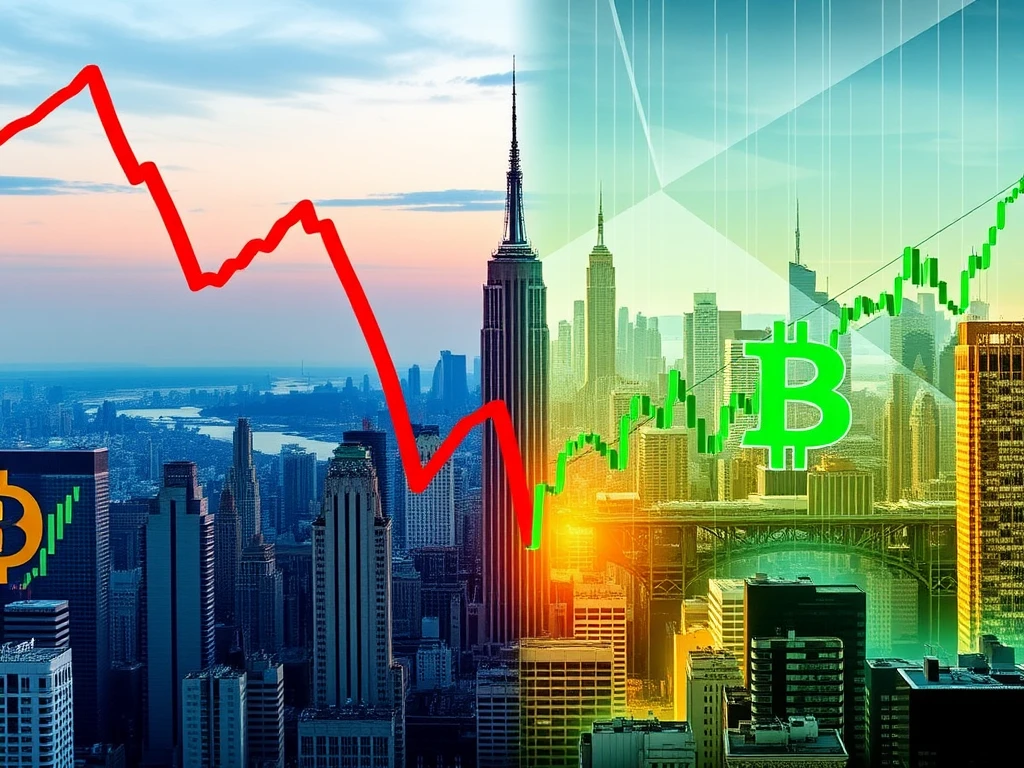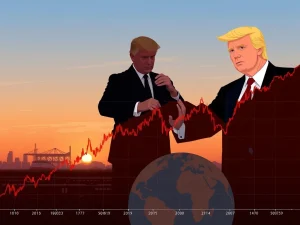Shocking Loss: Wall Street’s One-Day Plunge Exceeds Entire Crypto Market Cap

Hold onto your hats, crypto enthusiasts! A seismic event just shook the financial world, and it’s got everyone talking. Get ready for a jaw-dropping comparison that puts the sheer scale of traditional market volatility into stark perspective against the seemingly ‘risky’ world of cryptocurrency. Are you ready to learn how a single day of losses on Wall Street eclipsed the entire valuation of the crypto market? Let’s dive in.
Wall Street’s Devastating One-Day Loss
Imagine this: On April 4th, the US stock market experienced a bloodbath, shedding a staggering $3.25 trillion in value. Yes, you read that right – trillion with a ‘T’. This colossal wipeout wasn’t just a minor dip; it was a full-blown plunge fueled by escalating fears over President Trump’s newly announced tariffs. To put this into perspective, consider this mind-blowing fact:
- The total value lost by the US stock market on April 4th was $3.25 trillion.
- The entire cryptocurrency market cap at the time? A mere $2.68 trillion.
- This means Wall Street’s one-day loss was a whopping $570 billion more than the entire crypto market’s valuation!
This unprecedented financial event underscores the immense scale of traditional market movements and raises critical questions about perceived risk in both traditional finance and the burgeoning crypto space.
The Stock Market’s Bearish Turn: A Deeper Dive into the Wall Street Loss
The pain wasn’t spread evenly across the board; tech giants, particularly the ‘Magnificent Seven’, took a significant hit. Let’s break down some of the key losses:
| Stock | Ticker | Percentage Drop (April 4th) |
|---|---|---|
| Tesla | TSLA | 10.42% |
| Nvidia | NVDA | 7.36% |
| Apple | AAPL | 7.29% |
These dramatic declines signal that the Nasdaq 100 has officially entered a “bear market,” signifying a substantial and sustained downturn. According to The Kobeissi Letter, this was the largest daily decline since the tumultuous days of March 16, 2020. Adding fuel to the fire, they highlighted that US stocks have now evaporated a massive $11 trillion in value since February 19th, pushing recession odds above a concerning 60%. The catalyst? Trump’s tariff announcement, deemed “historic” by The Kobessi Letter, with warnings that a continued tariff regime makes a recession “impossible to avoid.”
Trump’s Tariffs: The Trigger for Stock Market Turmoil
On April 2nd, President Trump signed an executive order initiating reciprocal tariffs on trading partners and imposing a baseline 10% tariff on imports from all countries. His rationale? To level the playing field, arguing that reciprocal tariffs would be roughly half the rate that US trading partners currently impose on American goods. However, the market reaction was swift and severe, translating into the trillion-dollar stock market plunge and widespread investor anxiety.
Bitcoin’s Unexpected Resilience Amidst Stock Market Chaos
Now, here’s where things get really interesting for crypto enthusiasts. While the traditional stock market was reeling, Bitcoin (BTC) demonstrated surprising strength. In a world accustomed to crypto volatility, Bitcoin stood its ground, seemingly unfazed by the tariff-induced panic gripping Wall Street. Crypto trader Plan Markus succinctly pointed out on X (formerly Twitter) that while the entire stock market “is tanking,” Bitcoin is holding firm. This divergence has sparked a fascinating debate about Bitcoin’s role as a potential safe haven asset or at least, an asset with different drivers than traditional equities.
Even Crypto Skeptics Take Notice of Bitcoin’s Strength
Perhaps the most compelling aspect of this market event is the acknowledgment from unexpected corners. Even staunch crypto skeptics are starting to take notice of Bitcoin’s performance relative to the plummeting stock market. Dividend Hero, a stock market commentator with a substantial following, admitted on X, “I have hated on Bitcoin in the past, but seeing it not tank while the stock market does is very interesting to me.” Technical trader Urkel echoed this sentiment, stating Bitcoin “doesn’t appear to care one bit about tariff wars and markets tanking.”
At the time of writing, Bitcoin is trading around $83,749, showing a minor 0.16% decrease over the past seven days, according to CoinMarketCap data. This relative stability, especially compared to the dramatic swings in the stock market, is turning heads and prompting a re-evaluation of Bitcoin’s role in a turbulent global economy.
What Does This Mean for the Future of Crypto and the Stock Market?
This unprecedented event raises some crucial questions:
- Decoupling or Temporary Divergence? Is this a sign of Bitcoin truly decoupling from traditional markets, or is it a temporary divergence?
- Safe Haven Narrative? Does Bitcoin’s resilience strengthen the narrative of it being a safe haven asset in times of economic uncertainty?
- Tariffs and Global Economy: How will ongoing trade tensions and tariff wars impact both the stock market and the crypto market in the long run?
- Regulation and Adoption: Will events like these influence regulatory discussions and mainstream adoption of cryptocurrencies?
The coming weeks and months will be critical in observing whether this trend continues. The stark contrast between Wall Street’s dramatic Wall Street loss and Bitcoin’s steady performance has undoubtedly injected a new layer of intrigue into the crypto narrative. As traditional markets grapple with economic headwinds, the spotlight is increasingly turning towards the digital asset space, forcing even the staunchest skeptics to reconsider the potential of Bitcoin and the broader crypto ecosystem.
In Conclusion: The sheer magnitude of Wall Street’s one-day loss, dwarfing the entire crypto market cap, serves as a powerful reminder of the volatility inherent in traditional markets. Bitcoin’s surprising stability during this turmoil has not only captured the attention of the crypto community but has also sparked curiosity and even admiration from traditional finance observers. Whether this marks a fundamental shift or a temporary anomaly, one thing is clear: the financial landscape is evolving, and the interplay between traditional finance and the world of crypto is becoming increasingly complex and undeniably captivating.









